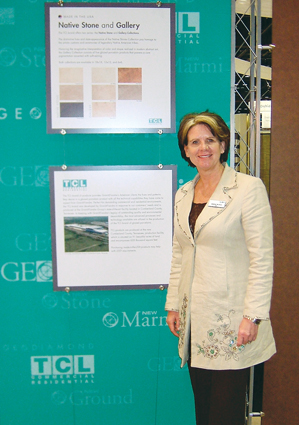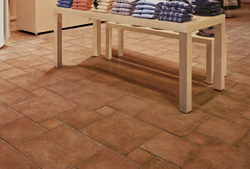 |
| Jeanne Nichols of Graniti Fiandre |
|
Hicksville, N.Y.—As the U.S. market learns more about ceramic and porcelain tile, the applications it is used for expands. What had been layed down, if at all at first, exclusively in the kitchen and bathroom is now being utilized in other rooms of the home, even outdoors. This isn’t only due to attractive colors and patterns, but toughness, durability and performance that are featured benefits of ceramic tile. What makes this so? Aside from being a hard surface, it is the way tile is constructed that adds to its durability.
“Manufacturing porcelain tile replicates the same extreme forces in nature that created the hardest materials on the planet,” said
Tim Bolby, director of technical services for
Crossville. “The usage of high quality, light colored kaolinite clays and large percentages of feldspar create a very dense, but moldable material. Next come the forming and compressing of the tile in a press with up to 6,000 pounds per square inch of force. This part of the process brings all of the small particles together into an extremely dense formation.
“Following the decoration to the face of the tile, the next step is firing,” he explained. “Porcelain tile is fired at 2,200 degrees Fahrenheit, this prompts the clays and feldspar ingredients to fuse together—virtually eliminating any airspace or gaps between the particles. The result is a product of lifetime durability (very often with through-body color) that is impervious to wear and weather.”
Ceramic tile and porcelain tile are two different types of products, noted
Massimo Ballucchi, director of porcelain tile for
Mannington Porcelain. “Porcelain is both harder and stronger than ordinary ceramic and can be used in areas where ceramic can’t—places where extraordinary durability is required. For example, Mannington porcelain has been used in commercial applications like car showrooms, retail stores and school cafeterias.
“The difference is in the way that the tile is made,” he explained. “Porcelain is fired at a much higher temperature than ceramic, which compresses the minerals in the tile body and results in a more dense product. Because of this hardness, it’s got a much higher breaking strength than ceramic and will outperform it in the more demanding applications, like those for commercial and exterior use.”
“There are many advantages to porcelain tile,” said industry consultant
Donato Grosser of
Grosser & Associates. “It is a very compact product, has low water absorption, close to 0%. It is an impervious product, and therefore you can use it anywhere. It is anti-frost and will not crack at relatively low temperature, so you can use it outdoors as well. That is its main advantage. You also have the monocouturra, a single fired tile, which has very low water absorption so you can also use it outdoors. You really can’t say monocouturra tile is worse than the porcelain tile, it’s just that today, the technology became porcelain tile.”
Matthew Kahny,
Daltile’s senior vice president of marketing, agrees with Grosser, in that tile’s low water absorption is a major benefit in its durability and applications. “Porcelain tile has low water absorption by definition, so it tolerates freeze/thaw conditions and changes in temperature quite well. Colorbody porcelains typically use glazes and other surface materials that give them good slip resistance and make them highly durable over many years without fading or changing appearance.
“Innovative technology allows many of today’s porcelains to replicate the look of stone and other materials that would not perform well in exterior environments,” he explained. “These products offer excellent performance and easy maintenance. The unlimited array of size and color options enable today’s porcelain products to solve virtually any design challenge.”
“Ceramic tile, porcelain especially, is the ideal material for use inside and out,” said
Noah Chitty, technical services director for
StonePeak. “The ability to resist freeze and thaw cycles, the low maintenance costs gained from the resistance to stains and chemicals, and the extended life cycle gained from the ability to resist scratches, dents and other damage are only a few of the reasons why tile is the ideal floor covering for all situations.”
Growing Applications
All the executives agreed, in the future, as more people in the American market learn about ceramic tile, the applications it will be used in will only increase. “We see the opportunity for tile continuing to grow,” said Ballucchi. “Homes today, whether they are new construction or remodeling situations, tend to have larger areas where hard surface flooring is used—like kitchens, baths and laundry areas—and more and more people choose the durability, easy maintenance and elegance of tile.
“In addition,” he continued, “tile can be used on more than just the floor—we see it on walls, countertops and exterior patios, as well.”
“Residentially, outdoor living areas and kitchens is a current trend that bodes well for tile selections,” said Kahny. “Commercial sales were strong and steady in 2005, and so far that trend has continued into the first part of 2006. We anticipate that key sectors for 2006 will be office buildings, the hotel industry, education and healthcare facilities.”
“Not only is ceramic tile versatile, but it is also durable—meeting the long term needs of residents and designers alike,” said
Jeanne Nichols, vice president of TransCeramica, Ltd., a
Graniti Fiandre company. “Stain, weather and chemical resistant, tile is an incredibly long-lasting material. Better setting materials and enhanced technical grout have improved the durability of today’s products. Tile is also now more resilient as a result of impact resistant materials such as porcelain and stronger glazes.”
“The ceramics business has and will continue to experience huge growth,” said Nichols, “which in large part is due to the continued technical enhancements we’re seeing today. Our sales have seen continued growth, which speaks to the great demand for tile in today’s marketplace. For 45 years, we have been at the forefront of design, providing the industry with diverse styles and variations. From our award-winning GeoDesign collection to our new TCL brand of glazed tile, we continue to develop innovative products. Moving forward, our styles will continue to evolve to meet the industry’s every-expanding needs.”
“Why is ceramic tile so good? asked Grosser. “Because it’s a product that will live forever. Ceramic tile, if you don’t want to change it, you can keep it forever. It will last as long as the house. It is also a product that is easy to clean, and gives you absolute hygiene because it does not absorb. The surface is an unglazed surface that is so good that nearly everything comes off. When you have that kind of product you can clean it perfectly. The colors do not fade, do not change, unlike any other type of surface.”
—Louis Iannaco
 |
| Mannington's Tuscan Valley |